
Connecting state and local government leaders
GCN Lab Review | As Windows Vista and some new applications create opportunities for split-screen work, you might want to think again about large LCD monitors.
Last year, we learned that bigger was not always better for LCD monitors. As sizes increased, quality tended to drop. But with new operating systems and programs such as Microsoft Vista and Office offering functional ways to use multipanel views, the desire for larger screens is greater than ever.
Thankfully, monitor companies are up to the challenge. Moving from mostly analog to digital connections was a good start, and advances in panel design, response times and color reproduction have also helped. One of the largest LCDs in this roundup, a 24-inch display from Eizo, ended up being one of the most accurate. Even entry-level large LCDs priced less than $500 performed well in this year's review, proving their worth for most common office tasks.
Each monitor in the review was graded primarily on image quality, which was tested using both internal GCN Lab benchmarks and the DisplayMate Technologies Professional benchmark suite. Each monitor was connected to a digital signal running through a SmartView multiport Digital Visual Interface video splitter, so each LCD was receiving exactly the same image through an ATI Radeon x1950 Pro digital video card. Where possible, each monitor was tested at its native resolution. A portable LX-101 light reader from Lutron Technologies was used in one test to measure the uniformity of screen brightness from the center of the screen out to the corners.
To a lesser extent, LCDs also were graded on their features, which included the placement and ease of use of the controls, the design of the monitor stand and any extras, such as an electric eye to sense light levels in the room or an integrated digital camera for videoconferencing.
Finally, value was based on its other scores relative to price.
It is worth mentioning that all the LCDs in the review this year were fairly good in most respects, and every one of them passed one important test: no blown pixels. This is the first year in which there was not one blown-out or stuck pixel to be found among any of the entries, a testament to the rigid quality control standards in the LCD market these days.
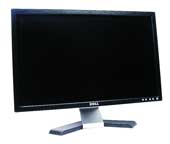
Dell E228WFP
GOOD START: Dell's E228WFP is the best entry-level LCD.
Image Quality: B+
Features: B
Value: A
Price: $309
Pros: Great price for a 22-inch monitor, crisp text play.
Cons: Light bleeds in from top and bottom of monitor.
The Dell E228WFP is an entry-level 22-inch LCD that performs nearly as well in many areas as more expensive displays.
Oddly enough, the E228WFP could produce a perfect gray field, which is one of the most difficult things for a monitor to do. The E228WFP did so better than any other LCD in this roundup. It also did extremely well when displaying text, which obviously is important to anyone who works in an office. It was not quite the best at text display, but was easily in the top three, with text that was readable even down to very small point sizes set against various colored backgrounds.
The E228WFP was also extremely good at reproducing fine details, even when other LCDs dropped them or blurred them into the background.
The E228WFP was cruising toward a possible Reviewer's Choice when its train came to a screeching halt at the black-screen test. The screen was a relatively uniform black across the entire field, but it had backlight bleeding in from the top and bottom of the screen. It was only noticeable on a pure black field at first but also showed up later when we were doing our color testing. Red fields that pushed up against the bleeding backlight turned orange, and green ones took on a yellow tint.
This turned out to be a problem for several LCDs in the review, and it's an unfortunate error in design because users can't do anything about it. Thankfully, the light bleed with the E228WFP was pretty minor, but it's still something to note if you are thinking about buying one. Most LCDs featured here had zero light bleed, so it's obviously a problem that companies have learned how to fix. For the Dell, this dropped its Image Quality score from an A- to a B+.
Beyond the light bleed, the screen was pretty uniformly bright, with only an 11 percent difference ' not noticeable to the naked eye ' in brightness levels between the center of the screen and the corners.
The E228WFP is a good LCD that offers great text quality and above-average image reproduction. Of the entry-level LCDs in this review, the E228WFP is the best.
With a $309 price tag for a 22-inch monitor, you will be getting a good deal on the E228WFP. The light bleeding in is a problem, but one that mostly text users probably won't mind because it's pretty minor. It could easily ruin a movie, however, or any application that works best with a black background.
Dell, (800) 999-3355, www.dell.com
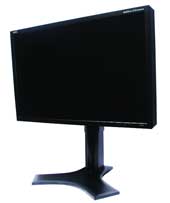
NEC LCD2490UXi
SCREEN STAR: The 24-inch NEC LCD2490UXi excelled in all display categories, especially readable text, and won a Reviewer's Choice designation.
Image Quality: A
Features: A+
Value: A-
Price: $1,351
Pros: Amazingly good controls, best in review at text display.
Cons: Slight orange tint to display of reds.
The NEC LCD2490UXi is a 24-inch, wide-screen LCD that performed great in all display testing and was the best in this review in one very important factor: readable text display.
Most office workers have to read text on their screens, so we look at a variety of fonts and sizes on the screen and also different colored backgrounds. In every one, text on the 2490UXi was crisp and readable, down even to a 6.5 point size for most fonts. If you have to read a lot, the 2490UXi offers a great display that won't induce eyestrain.

The 2490UXi is also very good at displaying high-intensity colors without bleeding and can accurately reproduce very fine color stepping without changing the hue or saturation of the native images. It also is extremely good at displaying fine images and was nearly as good in this area as the top-performing HP L2045w, which is five inches smaller.
Brightness is fairly uniform across the display, with only an unnoticeable 11 percent variance between the corners and the center.
The HP L2045w has an ingenious control scheme that features three horizontal and three vertical buttons. The screen lights up to display what each button does when pressed. The two sets of buttons are mirror images of one another.
Depending on how the screen is oriented in widescreen or portrait mode, you would use one or the other to adjust the screen and easily work the menus on the screen. Tweaking the performance of the 2490UXi is a breeze.
Also, the 2490UXi does the best job in this review of reducing the glare of objects in the room behind you. This may seem like a small matter, but the wrong lighting conditions can become a huge annoyance for users with lower-quality displays.
At $1,351, the 2490UXi is an expensive LCD. But it is a 24-inch display that handles itself extremely well, especially when displaying text output ' which is key for an office monitor ' in addition to video and images.
So if you want something big and good, the 2490UXi is a great choice. It earns a Reviewer's Choice designation for this review.
NEC Display Solutions, (866) 632-6673, www.necdisplay.com

NEC LCD223WXM
Image Quality: C-
Features: C-
Value: D
Price: $307
Pros: Good black display.
Cons: Screen brightness not uniform, poor color display, bad controls.
The NEC LCD223WXM is meant to be an entry-level widescreen 22-inch display. But despite a low price, the 223WXM came in dead last in almost all our display testing, features controls you have to really wrestle with and has no real strengths to redeem it. Any of the other entry-level LCDs featured in this review would be a better choice.
The list of flaws is long, starting with screen uniformity. There is a 16 percent difference in brightness between the center and the corners of the monitor. Even the pure black screen, which is among one of the 223WXM's strengths, is marred by some variation in the coloring.
The 223WXM displays lighter colors acceptably, but darker images are mostly lost. Reds and greens are a bit inaccurate. Grays are horrible, and text is only easy to read at sizes above about 13 points, depending on the font.
The controls run along the bottom of the screen in an oblong bar. The buttons are unresponsive and difficult to use with the small menu that pops up. Perhaps we were simply spoiled by the amazing control layout of the NEC 2490UXi, but the controls on this model were easily the worst in the review.
Even with a low $307 price, we can't recommend the 223WXM to anyone, especially given that there are much better entry-level choices in this review. It seems as if the 223WXM is playing in a league far above its skills.
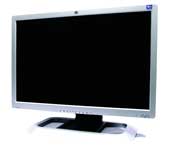
HP L2045w
DOWN TO DETAILS: The HP L2045W was impressive in its display of fine details and it's good for video viewing.
Image Quality: A
Features: B+
Value: A
Price: $279
Pros: Best at display of fine details.
Cons: Slight trouble with vivid color stepping.
The HP L2045w is one of the smallest displays in this roundup, with a 20-inch screen, but it also has one of the smallest prices. For just $279, you really can't go wrong with this extremely accurate monitor.
The biggest strength of the L2045w is its ability to display fine details accurately in images. In this respect, it was actually better than the top-dog Eizo s2431W. However, given the smaller screen size, fine detail display is a little bit easier, but no less impressive. In our testing, even images with tiny details ' such as the veins in a spring leaf ' were displayed, instead of becoming lost in the background as on other monitors.
The L2045w also is extremely accurate at displaying light colors on a white background. It was not as good trying to display the same colors on a dark background but still well above average and more than acceptable for most office tasks.
The screen is relatively uniform, with an unnoticeable 11 percent difference between the brightness at the center and the corners. It is also easy to read various text displays on the screen.
You don't get a lot in terms of extras, though the monitor stand does move in all directions and can rotate into portrait mode. There is a DVI and an RGB analog input in the back, but the most impressive extra is the 5-millisecond response time of the LCD, which makes it good for video and text display.
The L2045w is a good, inexpensive LCD without a lot of flaws. The 20-inch size may be a little small in terms of modern multiwindow applications, but typical office workers might not care very much.
Hewlett-Packard, (800) 289-6947, www.hp.com
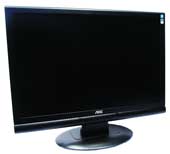
Envision AOC 212Va-1
FINE PRINT: The AOC 212VA-1 did better with images than with text.
Image Quality: B
Features: B
Value: A
Price: $299
Pros: Best blue in review, good LCD for watching video.
Cons: Poor text display.
The AOC 212Va-1 is a 21-inch display aimed at the entry level of the large-format LCD market. It does not offer a lot of frills but surprisingly does conjure above-average image quality on most tests, and it is particularly good when watching DVDs or streaming media.
The 212Va-1 happens to have the truest blue reproduction in the review, which is often a hint that a monitor is designed for displaying movies and video.
It also does a great job with lighter images on a light background, down to just a 2 percent red or green bar on a white background.
The screen is not uniformly bright, with the corners 18 percent dimmer than the center of an image. This is still not quite at the level (a 62-lumen difference) where the naked eye can tell, but it's on the border.
Also, darker colors tend to get a bit washed out on the screen, and text display is among the worst in the review ' text needs to be at about 10.5-point size to be readable.
For extras, the 1,680 by 1,050 native resolution widescreen display has an anti-glare treatment, and the LCD is set up to deliver 720p/1080i video, so it can accept an HDTV signal or one from a modern console computer game.
The 212Va-1 offers above-average quality in most areas for a great $299 price. It's obviously optimized for video and not that great with text display but, depending on your needs, might be a perfect way to get a large display without spending a lot of cash.
Envision Peripherals, (510) 770-0468, www.epius.com
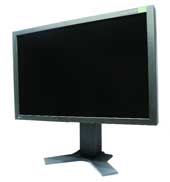
Eizo s2431W
BIG WINNER: Eizo's s2431W had the best overall quality.
Image Quality: A+
Features: A
Value: A
Price: $1,299
Pros: Excelled at every display test, uniform screen brightness, big screen.
Cons: Nothing significant.
The Eizo s2431W is a widescreen monitor that measures 24 inches along the diagonal, making it one of the largest in this review. It also is hands-down the best in terms of overall quality, which is surprising considering the size of the screen. The s2431W placed number one or two in every test.

The most impressive feature of the monitor is the uniformity of screen brightness. The center of the screen is almost exactly the same in terms of brightness as either the edges or the corners, making the monitor perfect even when looking at maps or medical images where slight differences in shading can mean big differences in reality. The edges of the screen are only 3 percent less bright than the center, the lowest variance in the review and not at all noticeable.
The s2431W also has the best pure black in the review, with no light bleeding onto the screen. The darkness, which is the base for many images, is completely uniform throughout the display, which contributes to the LCD's ability to display extremely fine details.
Color quality is also precise, with extremely vivid and accurate colors. It has the truest green in the review, and a perfect paper white, too. The monitor works best when set to its native resolution of 1,920 by 1,200, though it looks great at lower resolutions, too.
In terms of extras, the s2431W has a brightness regulator that will automatically sense the light level in a room and compensate. This is good if the LCD is placed in an office where the light levels change throughout the day, such as one with a large window facing the rising or setting sun. The monitor stand tilts and rotates the display in all directions, and the entire screen can be moved from widescreen to portrait orientation.
The $1,299 list price makes the s2431W one of the most expensive in the review, but this is definitely a case of getting what you pay for. A display this crisp and this large is worth every penny. The s2431W earns a Reviewer's Choice designation.
Eizo Nano Technologies, (800) 800-5202 x300, www.eizo.com
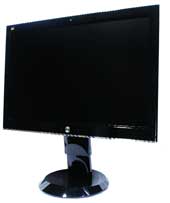
ViewSonic VX2255wmb
MIXED BAG: The VX2255wmb had strong and weak points.
Image Quality: C-
Features: B
Value: C-
Price: $429
Pros: Incorporates a digital camera into display, good blues.
Cons: Light bleeds in on top and bottom of display, brightness not at all uniform.
The ViewSonic VX2255wmb is an innovative 22-inch LCD with a lot of neat extra features that might make the $429 price attractive to some users. However, it just barely gets above-average marks in our display testing, and it has several significant flaws in its design.
The VX2255wmb has excellent color ramping and is able to display subtle variations in most colors, especially red and blue, without harming the hue or saturation of the original image. It is also fairly good at dark colors.
Two of its biggest faults are screen brightness uniformity and light bleed. There is a 23 percent difference in brightness between the center and the corners and edges, which is going to be noticeable to most people. This was the worst variance in the review. Also, the edge bezel itself does not hug the screen very well, allowing some white backlight to spill onto the screen at the top and bottom of the display, which tends to counter its good performance for displaying dark images. This is a design flaw that can't be compensated for by adjusting the monitor.
The VX2255wmb has a great monitor stand that can tilt in all directions. The coolest part, however, is the base of the stand, which is set up like a Lazy Susan so you can turn the monitor easily without much friction and without having to move the stand itself.
There is also a 1.3-megapixel camera mounted on top of the monitor, so you can do videoconferencing out of the box. However, we question why it is only 1.3 megapixels, considering most cell phones are better equipped. If you are going to add a camera to a monitor ' which we think is a great idea ' at least make it a good one.
The VX2255wmb is an above-average monitor with a lot of nice extra features. It is far from high end, but might be a good choice for casual users who need a large display.
ViewSonic, (727) 772-8668, www.viewsonic.com
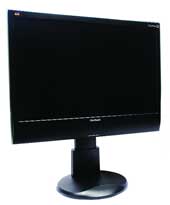
ViewSonic VG2230wm
BLINDED BY THE LIGHT: The VG2230wm has excessive light bleeding in from the top and bottom of the screen.
Image Quality: C-
Features: B
Value: C-
Price: $389
Pros: Nice turntable stand design, accurate greens.
Cons: Terrible light bleed, dark colors washed out, screen brightness not uniform.
The ViewSonic VG2230wm is a nice-looking display until you turn it on. Like the other ViewSonic in this review, this LCD has some flaws, but they are a bit more exaggerated on this unit.
The biggest problem with the VG2230wm is that there is a huge amount of light bleeding in from both the top and the bottom of the screen.
Especially at the bottom, where about a 1-inch area along the bezel is washed out by white backlight. This is a serious flaw because there is nothing a user can do to fix it.
LCDs can last 10 years or more, and nobody is going to want to live with a flaw like that for such a long time.
Even compensating for the light bleeding in, the screen is not uniformly bright. There is a 22 percent difference between the center and the corners, which most people will probably be able to notice.
The bleeding light and lack of uniformity combine to wash a lot of darker colors out when displayed on this LCD.
The VG2230wm does produce accurate greens and does an adequate job with text display. It also has the same innovative Lazy Susan stand as its sister monitor.
We could almost recommend the VG2230wm as an entry-level LCD, but the unfixable design flaw that leads to backlight bleeding in over the top and the bottom of the screen prevents this.
Even at $389, we think most users would feel they bought a defective product.
NEXT STORY: Vista per-diem gadget




